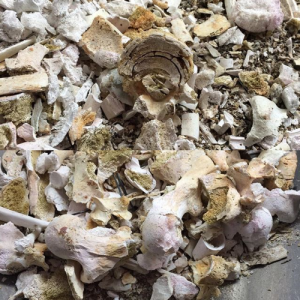Katy Meyers Emery
Source - http://www.bonesdontlie.com/
... Fire for many centuries in prehistory was a highly positive force. Fire allowed the cooking of food, the preparation of clean water, creation of metal, glass and ceramics, and it provided light. Fire was a source of regeneration- it made the world usable, approachable and safer. When we look at cremation from this perspective, it is not a destructive act; it is a way of transforming the dead into an ancestor.
Studies of cremation have lagged behind those of complete burials placed in the earth. There are many reasons for this, but the primary issue has been a perception that we cannot learn as much from the fragments of bone created in the cremation and that the time needed to do these types of analyses is not commensurate with the effort needed. Yes, studying cremated bone is more time consuming, but it is worth it because we can learn so much from them.
A new study by Becdelievre et al. (2015) proposes that burned human remains provide an important source of information for learning about past funerary practices. “Rather than being an impediment to archaeological analyses, physical alterations of burned bones may inform our understanding of the taphonomic processes of the combustion and sometimes of their cultural implications”. By examining the patterns of burning, we can interpret the how the cremation happened. The study examines remains found at the Truie Pendue site in France, dating from the Middle to the Late Neolithic periods. Excavations revealed three inhumation burials and a mortuary structure that held the remains fo 65 individuals. The structure acted as a kind of crypt whereby community members could add burials and visit the deceased. The crypt was divided into two layers: the uppermost contained the remains of 52 individuals whose bones were mixed together and showed signs of burning, and the lower layer contained 13 artifculated inhumation burials.
 Photo from the amazing @mrs_angemi of Instagram. Follow her immediately for amazing content.
Photo from the amazing @mrs_angemi of Instagram. Follow her immediately for amazing content.
In order to determine what occurred at this burial structure, a detailed analysis of the human bones is needed. First, Becdelievre et al. (2015) examined the external alterations to the bone. Color is one of the most important factors when analyzing cremated bone as temperature causes different colors to appear:
-
0 to 200/300 °C = orange, yellow, yellowish, tan, ivory, white
-
200/300 °C to 550 °C = dark brown and black
-
300 to 700 °C = grey, light grey to blue grey
-
600 to over 1000 °C = white, pale yellow white, white to light grey
Of course, this isn’t an exact science. The range of colors can also be effected by duration of the fire, how deep the bones are buried in the coals, and whether the body had flesh present at the time of burning. Another important factor to consider is how the bone shape and size changed with the fire as wapring and cracking can occur, and this is highly effected by the presence of soft tissue, presence of different fuel sources on the fire, handling of bones and how the fire was extinguished. Overall, Becdelievre et al. (2015) argue for a general pattern: that presence of soft tissue on the body produces extra fuel for the fire resulting in white, blue and grey colors, and warping, cracks and fractures. In order to account for all these possible changes, Becdelievre et al. (2015) create a scoring sheet that allows them to track changes in color, size and shape. These changes were then compared in space- they looked at the differences in burning that occurred on the bones within the mortuary structure.
Based on their analysis of the changes to the bone and their location in the structure,Becdelievre et al. (2015) conclude that the remains of 65 individuals had been placed in the mortuary structure over a number of years. When the structure was full, a fire was ignited at the top of the structure. It is likely that the uppermost dead were fresh corpses with flesh, and their bodies helped fuel the fire. Analysis of the burnt bone shows that the upper levels of bone are consistent with soft tissue patterns of color and warping, whereas those on the lower layers didn’t have the same intense heat and were dry when burned causing a different pattern of color and fragmentation. They propose a number of events at the site: 1) 13 individuals were laid out in the mortuary structure then buried, 2) 52 more skeletons were laid on top at a later date and were at varying stages of decomposition, and 3) the structure or uppermost deceased were burned causing the bones to be cremated.
Despite the effort needed for this study, the results demonstrate that it was worth it. We get a unique glimpse into this burial structure, and can better understand the funerary practices of this community. Usually when we think of cremation, we imagine the recently dead being burned prior to burial. Here, cremation acted as a secondary event- a closing ritual for ending the use of this mortuary structure. Fire acts as an important part of this funerary ritual, perhaps as a force of regeneration and purification. It is a great study, and if you get the chance, check out its fantastic appendices for information on how to classify cremated bone, great images of their GIS study, and more.
de Becdelievre, C., Thiol, S., Santos, F., & Rottier, S. (2015). From fire-induced alterations on human bones to the original circumstances of the fire: An integrated approach of human cremains drawn from a Neolithic collective burial Journal of Archaeological Science: Reports, 4, 210-225 DOI:10.1016/j.jasrep.2015.08.030